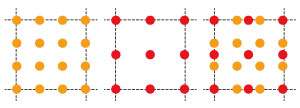Superimposing two lattices of similar periods to control and localize light

Brighter LEDs and more efficient solar cells are two potential applications for A*STAR's research into lattice structures that can slow or trap light.
Harnessing wave energy by localizing it and suppressing its propagation through a medium is a powerful technique. Now, Alagappin Gandhi and Png Ching Eng Jason from the A*STAR Institute of High Performance Computing have calculated a design that localizes light in tiny loops, within a two-dimensional structure created by merging two lattices of slightly differing periodicities.
The new technique is not limited to light, and may enable the design of systems that can precisely control wave energy in any realm and at any scale—sound, thermal, water, or even matter waves such as in Bose-Einstein condensates.
For light-based devices the new insights could be used to build more efficient photonic components, said Gandhi.
"If you pattern the surface of an LED with merged lattices it will assist with getting the light out efficiently," said Gandhi. "For a solar cell, however merged lattices will help light to enter better so that more energy can be harvested."
The ability to create resonators in which light is localized on the surface of a device also has applications in quantum computing components based on light, such as defects in diamond.
Gandhi and Png designed the structures by superimposing lattices of small circular dielectric materials with periods in a simple ratio R:R-1—for example one lattice is merged with another whose spacing is 4/3 as big, or 5/4, 6/5 etc.
"It creates a two-dimensional effect similar to beats between two waves of very close frequency," Gandhi said. "Where there are antinodes the light is localized in the form of a closed path."
Gandhi said the creation of a regular array of localized loops of light contrasted with Anderson Localization, which arises from randomness in a structure. "This is a systematic way of creating a large number of loops," Gandhi said.
Gandhi and Png ran numerical simulations of the propagation of light in a range of wavelengths slightly below that of the lattice spacing, and calculated the energy band structure. They found that as R increased, there emerged a large number of energy bands whose light had a group velocity of zero, the signature of light localized within the crystal.
Gandhi said merged lattices would also provide a way for researchers to explore topological properties, such as protected edge modes.
More information: G. Alagappan et al. Localization of Waves in Merged Lattices, Scientific Reports (2016). DOI: 10.1038/srep31620
Journal information: Scientific Reports



















